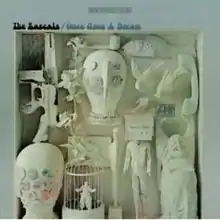| Once Upon a Dream | ||||
|---|---|---|---|---|
 | ||||
| Studio album by | ||||
| Released | February 19, 1968 | |||
| Recorded | September 21, 1967 – November 16, 1967 | |||
| Genre | ||||
| Length | 36:04 | |||
| Label | Atlantic | |||
| Producer | The Rascals, Arif Mardin | |||
| The Rascals chronology | ||||
| ||||
| Singles from Once Upon a Dream | ||||
| ||||
Once Upon a Dream is the fourth studio album by the rock band the Rascals, released February 19, 1968. The album rose to number 9 on the Billboard Top LPs chart and number 7 on the R&B chart.
History
Once Upon a Dream was the band's first album billed as "The Rascals"; they had, for legal reasons, been known as "The Young Rascals" until this time. It was also the last Rascals album to be available in both mono and stereo mixes.
The album was received differently by fans and critics. Many consider this album to be the band's best work, while others insist that it was too different from their traditionally rhythm and blues influenced music. Lead vocals came from both Eddie Brigati and Felix Cavaliere, as well as from Eddie's brother and unofficial band member David Brigati (on "Finale: Once Upon a Dream") and Gene Cornish on his own number, "I'm Gonna Love You."[2]
In an interview with Melody Maker in 1967, Cavaliere stated, "Our new album, and I say this in a humble way, will be Sgt. Pepperish." The album uses frequent sound effects and spoken words between the songs.[2]
A single of "It's Wonderful" (credited to "The Young Rascals," the band's last recording to be so billed) was issued November 27, 1967 and peaked at number 20 on the Billboard Hot 100 chart. The single version[3] ends with a 50-second coda of "Mardi Gras"-style special effects and party sounds that were not included in the album version.
The album was reissued on CD August 28, 2007 by Collectors' Choice Music.
Reception
| Review scores | |
|---|---|
| Source | Rating |
| Allmusic | |
In his review for Allmusic, music critic Thom Jurek, who highly praised the album, noted the influence of Sgt. Pepper's Lonely Hearts Club Band and wrote the Rascals "put their own spin on it by adding their trademark blue-eyed soul and jazz influences to the mix of psychedelia... All details aside, though, a listen to this platter is startling. Its sophisticated orchestral and vocal arrangements are remarkable even in the 21st century... It's an under-celebrated masterpiece of the psychedelic era and belongs next to Pet Sounds and Sgt. Pepper's on the shelf because it is easily as sophisticated, and once heard in its entirety, can never be forgotten."[4]
Track listing
All songs are written by Felix Cavaliere and Eddie Brigati, except where otherwise indicated.
Side One
- "Intro: Easy Rollin'" – 3:14
- "Rainy Day" – 3:39
- "Please Love Me" – 2:03
- "Sound Effect"
- "It's Wonderful" – 3:24
- "I'm Gonna Love You" (Gene Cornish) – 2:33
- "Dave & Eddie"
- "My Hawaii" – 4:13
Side Two
- "My World" – 2:54
- "Silly Girl" – 2:42
- "Singin' The Blues Too Long" – 5:10
- "Bells"
- "Sattva" – 4:23
- "(Finale): Once Upon a Dream" – 3:53
Personnel
The Rascals
- Felix Cavaliere – vocals, keyboards, sitar
- Eddie Brigati – vocals, percussion, tamboura
- Gene Cornish – vocals, guitar
- Dino Danelli – drums, tabla
Additional musicians
- David Brigati – vocals
- Chuck Rainey – bass
- Ron Carter – bass
- Richard Davis – bass
- King Curtis – tenor saxophone
- Hubert Laws – flute
- Melvin Lastie – trumpet
- Buddy Lucas – harmonica
- Steve Marcus – soprano saxophone
Production
- Arif Mardin – producer, arranger, conductor
- Gene Orloff – strings
- Tom Dowd – engineer
- Joe Atkinson – mastering
- Phil Iehle – mastering
- Bill Inglot – mastering
- Dave Schultz – mastering
- Jean Ristori – mastering
- Adrian Barber – sound effects
- Andree Buchler – coordination
- Thierry Amsallem – coordination
- Dino Danelli – cover sculpture, design
- Mark Roth – photography
- Urs Tschuppert – design
- Richie Unterberger – reissue liner notes
References
- ↑ Segretto, Mike (2022). "1968". 33 1/3 Revolutions Per Minute - A Critical Trip Through the Rock LP Era, 1955–1999. Backbeat. pp. 192–193. ISBN 9781493064601.
- 1 2 Unterberger, Richie. "Once Upon a Dream > Reissue liner notes". Richie Unterberger. Retrieved September 15, 2011.
- ↑ Atlantic catalog no. 2463.
- 1 2 Jurek, Thom. "Once Upon a Dream > Review". Allmusic. Retrieved September 14, 2011.